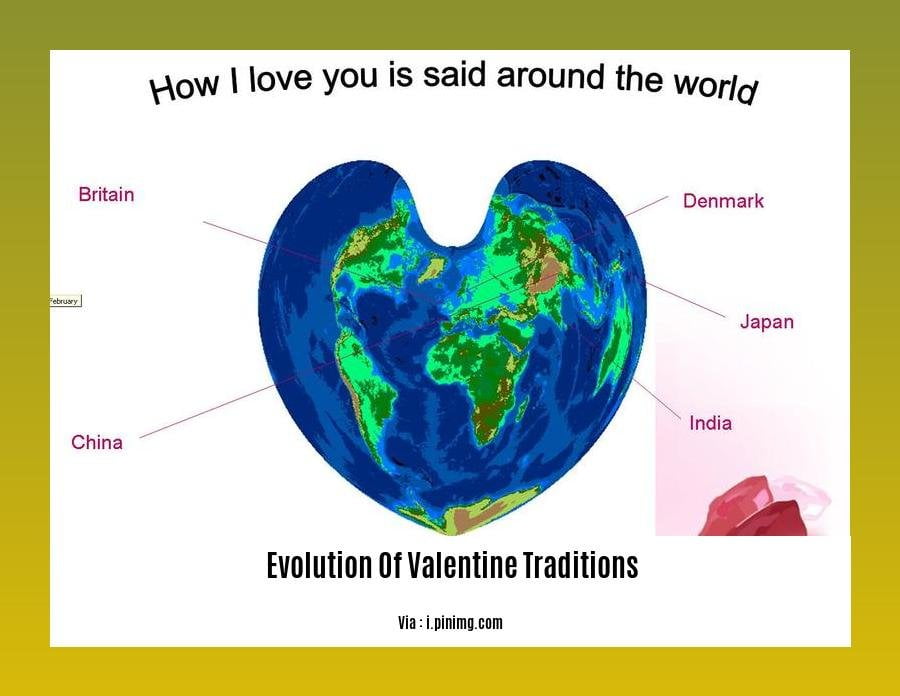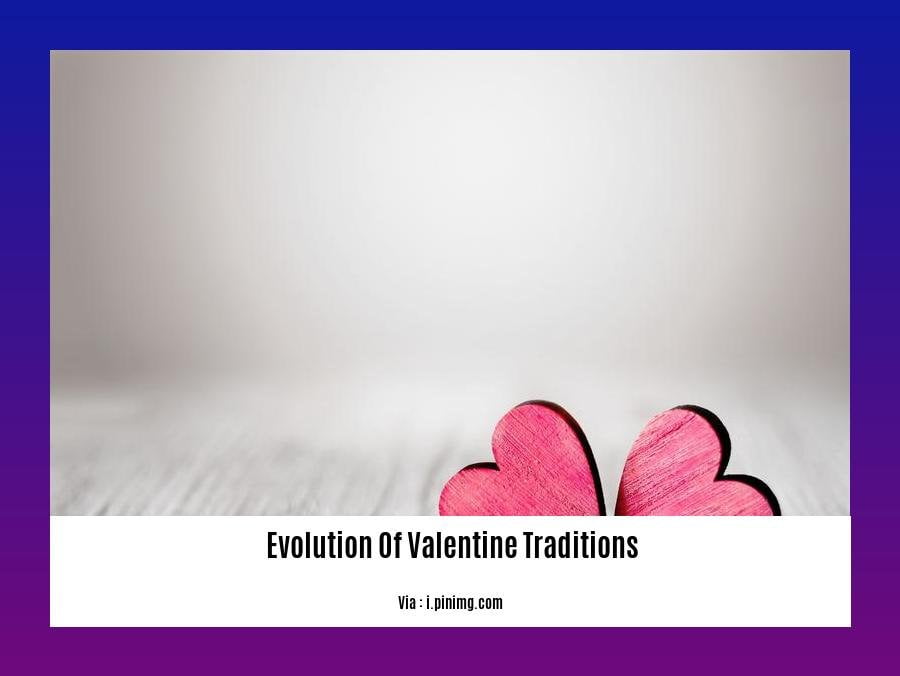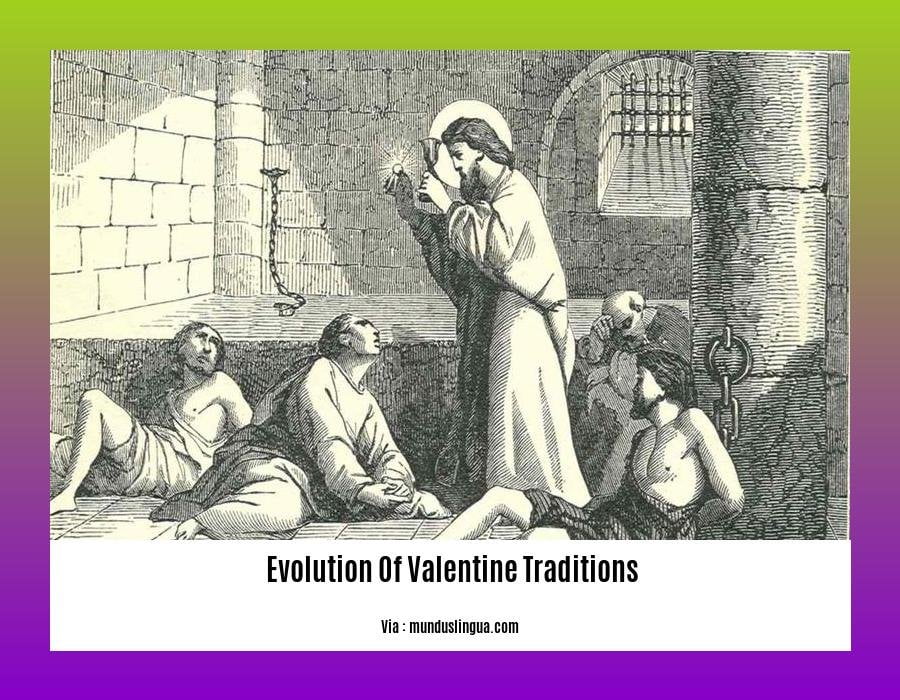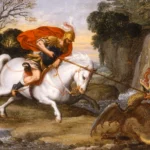Step into the captivating realm of [- The Evolution of Valentine Traditions: Tracing the Transformation of a Romantic Holiday]. Join us on a historical odyssey as we unravel the fascinating evolution of Valentine’s Day, exploring its origins, transformations, and the enduring legacy of love that it represents.
Key Takeaways:
- Valentine’s Day originated from Roman festivals and Christian traditions.
- Saint Valentine’s association with the holiday stems from his martyrdom and alleged role in secret marriages.
- The Victorian era marked the rise of romantic card and gift exchanges.
- Modern platforms like MonroeMatch are shaping Valentine’s Day connections in the digital age.
Evolution of Valentine Traditions

Valentine’s Day has come a long way from its humble beginnings as a pagan festival.
In ancient Rome, people celebrated Lupercalia, a fertility festival, on February 15th. During Lupercalia, young men would whip women with goat hide strips, believing it would make them fertile.
Jump ahead to the Middle Ages, and Valentine’s Day became associated with courtly love and chivalry. Young couples wrote love letters, exchanged gifts, and sang songs to each other.
The Evolution of Valentine traditions continued in the Victorian era, when Valentine’s Day became a time for exchanging elaborate cards and gifts. These cards were often decorated with hearts, flowers, and lace. They frequently contained romantic poems and messages of affection.
Today, Valentine’s Day is celebrated all over the world. People exchange gifts, cards, flowers, and chocolates with their loved ones. It’s a day to celebrate love and romance.
The Evolution of Valentine traditions has been influenced by many factors, including:
– Social norms
– Religious beliefs
– Economic conditions
– Technological advances
Despite these changes, Valentine’s Day remains a popular holiday that celebrates love and romance.
Uncover the fascinating origins of Valentine’s Day by delving into the Origins of Valentine Day. Dive into the rich tapestry of its history and discover the intriguing tales that have made this day so cherished.
Medieval Courtly Love and the Exchange of Gifts
In the captivating world of medieval courtly love, the exchange of gifts held profound significance. It was a tangible expression of the deep-seated devotion and adoration that permeated this highly formalized code of behavior.
The Gift of Chivalry
Knightly knights, bound by an unwavering sense of chivalry, bestowed gifts upon their beloved ladies as a token of their unwavering protection and service. These gifts often took the form of lavish jewelry, ornate weapons, or symbolic items that reflected their martial prowess and devotion.
The Gift of Poetry
Courtly love found its voice in the eloquent verses of poetry. Knights poured their hearts and souls into sonnets, songs, and ballads, which they exchanged with their ladies as a testament to their love. The power of poetic expression became an integral part of the gift-giving ritual.
The Gift of Adoration
The exchange of gifts in medieval courtly love was not merely a superficial gesture but a reflection of the profound reverence that the lover held for the beloved. Each gift was a symbol of the knight’s boundless affection, his unwavering admiration, and his desire to express the inexpressible through tangible tokens.
Key Takeaways:
- The exchange of gifts was an integral part of courtly love.
- Gifts symbolized chivalry, devotion, and adoration.
- Poetry was a powerful medium for expressing love through gifts.
- The gift-giving ritual reflected the hierarchical social structure of the time.
Sources:
* Courtly Love | Definition, History, Rules, & Examples | Britannica
* The Art of Courtly Love: 31 Medieval Rules for Romance
18th-Century Romantic Sentiments and Mass Production

In the 18th century, the notion of romantic love blossomed in the hearts of Europeans. This cultural shift ignited a surge in the exchange of handmade valentines, crafted with intricate designs and heartfelt messages. These early valentines served as tangible expressions of affection, carrying the weight of romantic sentiments.
As the 19th century dawned, industrialization swept across the globe, and so did mass production. In 1840, Esther A. Howland, an American businesswoman, seized this opportunity by producing the first commercially available Valentine’s Day cards. Her cards, adorned with delicate lace and elegant imagery, instantly captured the hearts of the public.
Mass production transformed Valentine’s Day into a widespread celebration, extending its reach beyond the social elite. The accessibility of these cards democratized the expression of love, allowing people from all walks of life to participate in this romantic tradition.
Key Takeaways:
- The 18th century witnessed a rise in romantic sentiments, fostering the exchange of handmade valentines.
- Mass production in the 19th century made Valentine’s Day cards widely accessible, democratizing the expression of love.
- Esther A. Howland is credited with producing the first mass-produced Valentine’s Day cards in 1840.
Relevant URL Sources:
- The History of Valentine’s Day – Origins, Facts and Tradition
- Valentine’s Day 2024: Origins, Background & Traditions
Modern Commercialization and Cultural Impact of Valentine’s Day
From its humble origins in ancient Rome, Valentine’s Day has undergone a remarkable transformation. Today, it has become a global holiday synonymous with modern commercialization and cultural impact.
The Rise of Romance and Consumerism
The 19th century witnessed a surge in mass-produced Valentine’s Day cards and gifts. This industrial revolutionized the holiday, making it accessible to a wider audience. Coupled with the rise of romantic literature and love stories, it popularized Valentine’s Day as a celebration of romantic love.
The Focus on Gift-Giving
Over time, the exchange of presents has become a central aspect of Valentine’s Day. From chocolates and flowers to lavish jewelry, the giving of gifts acts as a tangible expression of affection. This commercialized aspect has transformed the holiday into a significant revenue generator for various industries.
The Global Cultural Impact
Valentine’s Day has transcended its Western origins, becoming a popular celebration worldwide. Different cultures have adapted and integrated it into their local traditions. In some countries, such as Japan, it’s known as the “Day of Chocolate,” with an emphasis on giving chocolates to loved ones. In South Korea, it’s celebrated twice, with men giving gifts on February 14th and women reciprocating on March 14th.
Key Takeaways:
- Valentine’s Day has undergone a significant modern commercialization since its humble beginnings.
- The exchange of gifts has become a central part of the holiday, boosting consumer spending.
- Valentine’s Day’s cultural impact extends beyond Western borders, with unique adaptations in different countries.
Relevant URL Sources:
- Valentine’s Day History and Origin – The History Channel
- A History of Valentine’s Day: How It Became a Romantic Holiday
FAQ
Q1: When and where did the tradition of exchanging Valentine’s Day cards originate?
A1: The tradition of exchanging Valentine’s Day cards began in the 19th century, with mass-produced cards first sold in the 1840s by Ester A. Howland.
Q2: How did courtly love influence the evolution of Valentine’s Day?
A2: Courtly love, a romantic ideal popular in the Middle Ages, emphasized the devotion and adoration of a knight for his lady. This ideal influenced the development of Valentine’s Day as a time for expressing romantic love and affection.
Q3: What is the historical significance of Saint Valentine in the celebration of Valentine’s Day?
A3: Saint Valentine was a priest and martyr in the 3rd century. In the 5th century, Pope Gelasius I established February 14th as Saint Valentine’s Day, honoring his martyrdom and associating the holiday with love and romance.
Q4: How has the commercialization of Valentine’s Day impacted its significance?
A4: The commercialization of Valentine’s Day, particularly in the 19th century with the mass production of cards and gifts, has led to a focus on romantic love and gift-giving, which has both positive and negative implications for the holiday’s meaning.
Q5: In what ways has Valentine’s Day evolved from its ancient origins to modern times?
A5: Valentine’s Day has evolved significantly since its origins in ancient Roman festivals and Christian traditions. It has been influenced by courtly love, industrialization, and cultural changes, leading to its current form as a highly commercialized holiday centered on romantic love and gift-giving.












